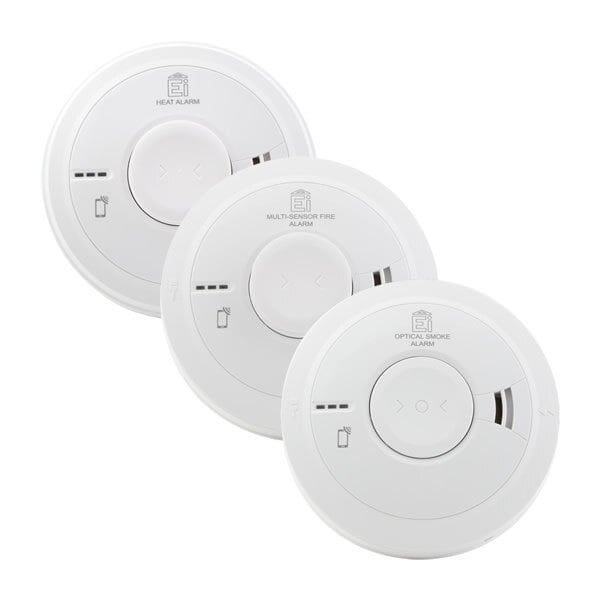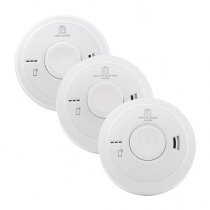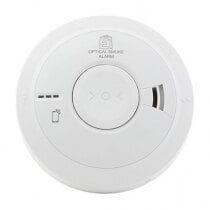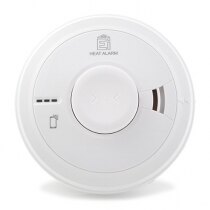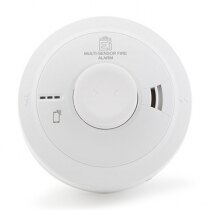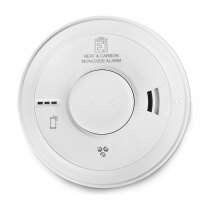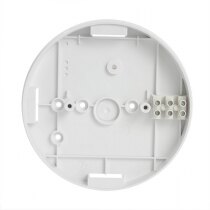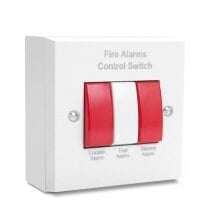-
Contact
Sales & Customer Service
0800 612 6537 support@safelincs.co.uk Live ChatDelivery Enquiries
0800 077 6149 - Resources
Fire & Safety Solutions
CALL OUR TEAM NOW 0800 612 6537
Lines open today 8am - 6pm
Quick Delivery
From £3.19 inc VAT
Live Chat - Online
Instant help & Advice
Trade Discounts
and exclusive pricing
0% Credit Available
Open an account now
5 Star Customer Feedback
Mains Powered Smoke Alarms & Heat Alarms with Self-Charging 10 Year Back-up Battery - Aico Ei3000 Series
Product Overview
Interlink
Technical Data
FAQs (1)
The Ei3000 series features a selection of mains powered smoke and heat alarms fitted with sealed rechargeable lithium back-up batteries designed to last for the entirety of the alarm, without needing replacement. The four versions available are optical, heat, combined optical & heat, and combined heat & carbon monoxide. Up to 12 alarms can be hardwire interlinked or by using the Ei3000MRF SmartLINK module, can be interlinked wirelessly. All alarms are fitted with AudioLINK as standard and when activated provide a loud 85dB warning alarm at 3m.
- 230V mains powered alarms with rechargeable lithium back-up batteries
- Available in four versions
- Optical Smoke Alarm (Ei3016) – Used in hallways, landings, living rooms, bedrooms and dining rooms
- Heat Alarm (Ei3014) – Used in kitchens and garages
- Combined Optical Smoke and Heat Alarm (Ei3024) – Used in hallways, landings, living rooms, bedrooms and dining rooms
- Combined Heat and Carbon Monoxide Alarm (Ei3028) – Used in kitchens and garages
- AudioLINK technology allows users to extract real time data to their smart phone or tablet
- All units feature a combined test and silence button
- 85dB warning alarm at 3m
- Suitable for installations needing to comply to BS 5839-6: 2019 Grade D1
- 5 year manufacturer's warranty
- SmartLINK compatible when used with Ei3000MRF offering many new features as well as radio-interlinking of alarms
- CE and Kitemarked to all relevant British Standards
- BS EN 14604: 2005 (Ei3016 and Ei3024)
- BS 5446-2: 2003 (Ei3014, Ei3024, and Ei3028)
- BS EN 50291-1 (Ei3028)
- Up to 12 compatible devices can be interlinked to form a smoke alarm system
- Memory feature – easy to identify an alarm that has previously sounded
- An interlinked system provides the earliest possible warning of fire
- Please note: Alarms sold separately
- This alarm is also suitable for both the Welsh and Scottish updated 2022 legislation
Please note: Ei3000MRF SmartLINK Module for radio-interlinking is sold separately.
The tables below show all the products that can interlink with these alarms.
More products may be compatible when installed in conjunction with the Ei3000MRF SmartLINK module.
Smoke and Heat Alarms
|
Model Number
|
Type of Unit
|
Type of Interlink
|
| Ei3014 / Ei3014RF | Mains Powered Heat Alarm - Sealed Lithium | Hardwire Interlink |
| Ei3016 / Ei3016RF | Mains Powered Optical Smoke Alarm - Sealed Lithium | Hardwire Interlink |
| Ei3024 / Ei3024RF | Mains Powered Optical & Heat Alarm - Sealed Lithium | Hardwire Interlink |
| Ei3028 / Ei3028RF | Mains Powered Heat & Carbon Monoxide Alarm - Sealed Lithium | Hardwire Interlink |
| Ei2110e / Ei2110eRF | Mains Powered Multi Sensor Smoke & Heat Alarm - Sealed Lithium | Hardwire Interlink |
| Ei161e / Ei161eRF | Mains Powered Ionisation Smoke Alarm - Sealed Lithium | Hardwire Interlink |
| Ei164e / Ei164eRF | Mains Powered Heat Alarm - Sealed Lithium | Hardwire Interlink |
| Ei166e / Ei166eRF | Mains Powered Optical Smoke Alarm - Sealed Lithium | Hardwire Interlink |
| Ei141 / Ei168RC141RC | Mains Powered Ionisation Alarm - 9V Alkaline | Hardwire Interlink |
| Ei144 / Ei168RC144RC | Mains Powered Heat Alarm - 9V Alkaline | Hardwire Interlink |
| Ei146 / Ei168RC146RC | Mains Powered Optical Smoke Alarm - 9V Alkaline | Hardwire Interlink |
Carbon Monoxide Alarms
|
Model Number
|
Type of unit
|
Type of interlink
|
| Ei3018 / Ei3018RF | Mains Powered Carbon Monoxide Alarm - Sealed Lithium | Hardwire Interlink |
| Ei3028 / Ei3028RF | Mains Powered Heat & Carbon Monoxide Alarm - Sealed Lithium | Hardwire Interlink |
| Ei261 | Mains Powered Carbon Monoxide Alarm - Sealed Lithium | Hardwire Interlink |
Ancillary Products
|
Model Number
|
Type of unit
|
Type of interlink
|
| MCP401RC | Mains Powered Manual Call Point | Hardwire Interlink |
| Ei1529RC | Mains Powered Locate, Silence & Test Control Switch | Hardwire Interlink |
| Ei159 | Mains Powered Smoke Alarm Locator Switch | Hardware Interlink |
| Ei128R | Mains Powered 5A Relay Module | Hardwire Interlink |
| Ei128RBU | Mains Powered 5A Relay Module with Lithium Backup Battery | Hardwire Interlink |
| Y03 | Mains Powered Multi Frequency Sounder | Hardwire Interlink (via relay) |
| SAB300C | Mains Powered Flashing Xenon Strobe (Clear) | Hardwire Interlink (via relay) |
| SAB300R | Mains Powered Flashing Xenon Strobe (Red) | Hardwire Interlink (via relay) |
Wiring Explained
Mains powered Ei Electronics smoke and heat alarms require a 230V AC power supply and up to 12 alarms can be hardwire interlinked in one system.
To obtain a mains power supply, each alarm can be connected to the nearest lighting circuit using 2 core and earth cable with a separate, dedicated interlink cable connecting all alarms. However, if possible it is recommended that the alarms are all powered from a dedicated circuit from the distribution board using 3 core and earth cable for safety during maintenance, as the interlink cable will carry power from live alarms on other power circuits. Please see the diagram below:-
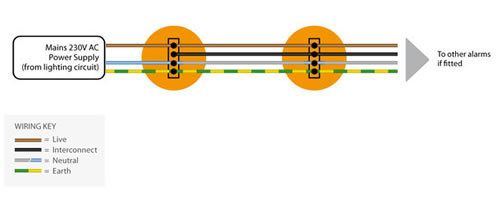
| Product Code |
Ei3016 Optical Smoke Alarm: EI3016 Ei3014 Heat Alarm: EI3014 Ei3024 Combined Smoke and Heat Alarm: EI3024 Ei3028 Combined Heat and CO Alarm: EI3028 |
|---|---|
| Brand | EI Electronics |
| Back-Up Battery | 10 year sealed lithium |
| Operating Temperature | 0°C to 40°C |
| Relative Humidity | 15% to 95% Relative Humidity |
| Sound Output | 85dB |
| Weight | EI3016: 0.402kg EI3014: 0.378kg EI3024: 0.412kg EI3028: 0.378kg |
| Product Datasheets |
Q. What sort of smoke alarm system would I need to install for a HMO?
A.
BS 5839-6 recommends that one or two storey HMOs with an individual floor area of no more than 200sqm (not the total of both floors) should have a Grade D smoke alarm system installed. Grade D refers to mains powered smoke alarms with a back up battery power supply. The alarms can be interlinked either by wire or by radio signal and the system does not require a separate fire alarm panel. For HMOs of 3 storey or higher, a Grade A panel system would need to be installed. This can cover the whole of the building, or can be used just for the communal areas with a separate Grade D system installed for the individual dwellings. For both applications, the level of cover should be a minimum of LD3 (in all escape routes) but this may change according to the fire risk assessment.
Pricing & Availability
| Model | Stock | Price |
|---|---|---|
|
Ei3016 Optical Smoke Alarm Product Code: EI3016 |
Stock Level:
More than 20 in stock Expected dispatch: Today
|
Price:
£53.99 inc VAT £44.99 ex VAT |
|
Ei3014 Heat Alarm Product Code: EI3014 |
Stock Level:
More than 20 in stock Expected dispatch: Today
|
Price:
£55.07 inc VAT £45.89 ex VAT |
|
Ei3024 Combined Smoke and Heat Alarm Product Code: EI3024 |
Stock Level:
15 in stock Expected dispatch: Today
|
Price:
£68.63 inc VAT £57.19 ex VAT |
|
Ei3028 Combined Heat and CO Alarm Product Code: EI3028 |
Stock Level:
9 in stock Expected dispatch: Today
|
Price:
£85.79 inc VAT £71.49 ex VAT |
Delivery Options
The following delivery options are available on this product.
Customer Reviews
4 customers have given this product an overall rating of 5 out of 5
Reviews by real customers
All of our product reviews are written by real customers that have purchased this product from us and are published without modification.Rating: 5 / 5 Stars
Reviewed by: D K
Much better than the model it replaced bought at a reasonable price.
Published on: 20th December 2023
Rating: 5 / 5 Stars
Reviewed by: M W
Good quality, easy to install and operate
Published on: 20th June 2022
Rating: 5 / 5 Stars
Reviewed by:
Reasonable value, easy to install, no false alarms so far.
Published on: 24th April 2020
Looking for more information?
If you have any questions or would like more information about this product you can ask one of our specialists.
Live Chat Available Now
Direct Telephone
01507 464181





















